Vegan Globetrotter is supported by our audience. When you purchase through one of our links, we may earn a small affiliate commission. As an Amazon Associate I earn from qualifying purchases. Your cost is not affected.
==================
A Vegan Grain Bowl is a meal that’s as colorful as a rainbow, as nutritious as a multivitamin, and as delicious as your favorite comfort food. It combines vibrant veggies, hearty grains, and a medley of flavors in one irresistible dish. Whether you’re a seasoned plant-based eater or just curious about incorporating more wholesome meals into your diet, this guide will unveil the five basic components that make up the perfect Vegan Grain Bowl. Get ready to transform simple ingredients into a feast for your eyes and taste buds. Let’s dive in!
How to Build a Vegan Grain Bowl- 5 Basic Components for a Nutritious Meal
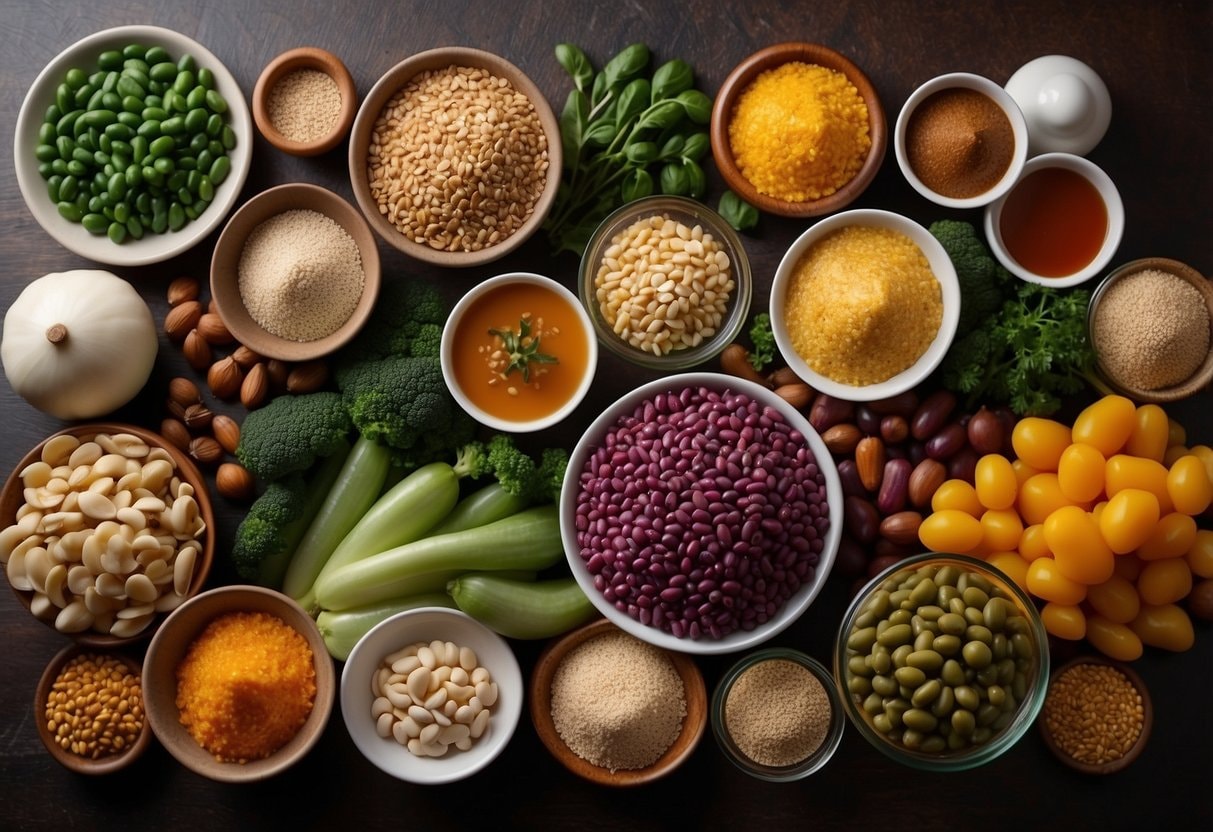
Building a perfect vegan grain bowl can be easy and exciting when you know the right components to include. The five basic components are grains, proteins, vegetables and fruits, healthy fats, and dressings. These elements add variety to your meal and ensure you get a balanced, nutritious bowl.
I lay the foundation with a hearty grain like quinoa, brown rice, or farro. Then, I add protein-rich foods such as chickpeas or tofu. Fresh vegetables and fruits like spinach, kale, or avocados brighten the bowl while adding essential nutrients. I incorporate healthy fats like nuts, seeds, or a drizzle of olive oil to make it even tastier. Toppings like tahini dressing or hummus enhance the flavors, making each bite satisfying and delicious.
Key Takeaways
- Choose hearty grains like quinoa, brown rice, or farro to form the base of your bowl. These grains provide essential nutrients and a satisfying texture.
- Include plant-based proteins such as chickpeas, tofu, or tempeh. These proteins help keep you full and provide essential amino acids for a balanced meal.
- Add fresh vegetables and fruits like spinach, kale, bell peppers, avocados, and berries. These not only add vibrant colors but also essential vitamins and minerals.
- Enhance your grain bowl with healthy fats from avocados, nuts, seeds, or olive oil. These fats contribute to a creamy texture and boost nutritional value.
- Elevate the taste of your grain bowl with homemade dressings like tahini, lemon vinaigrette, or balsamic glaze. Toppings like fresh herbs, crunchy nuts, and seeds add the final touch, making each bite satisfying and delicious.
Understanding the Essentials of a Vegan Grain Bowl
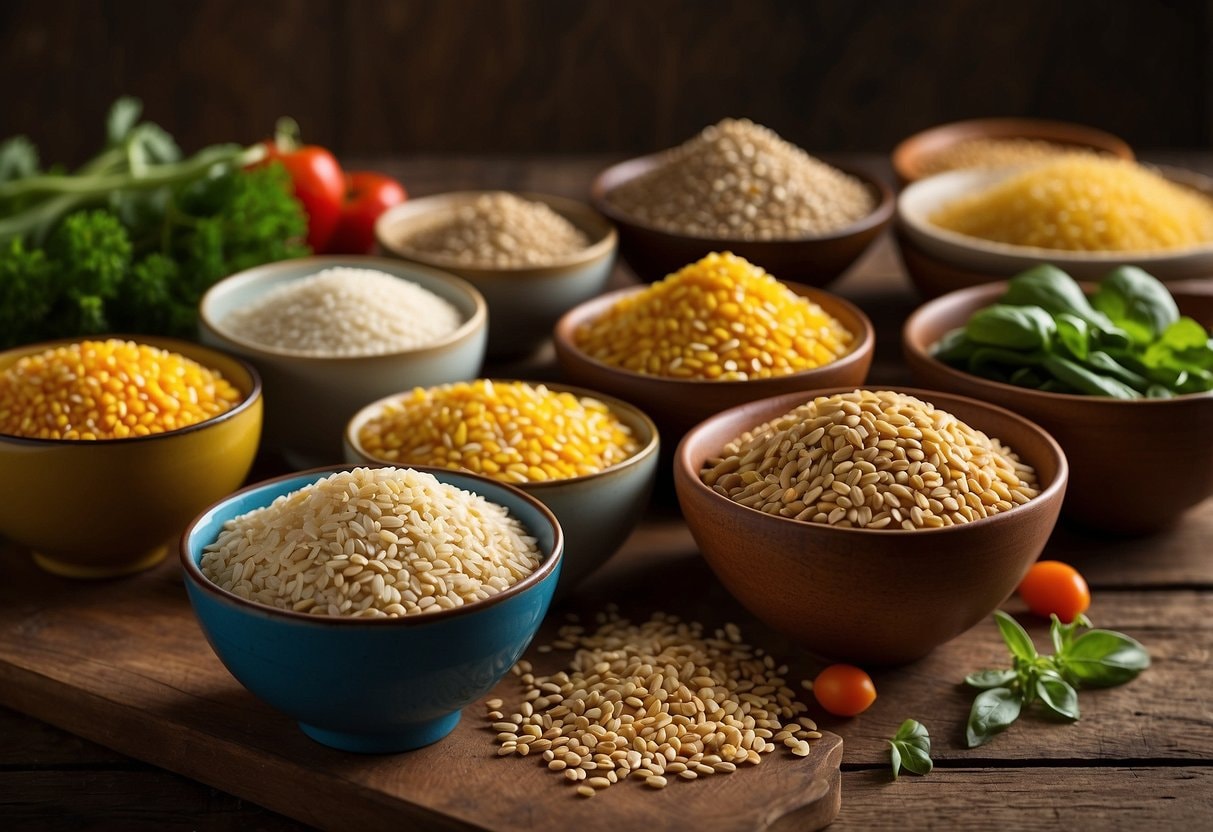
Creating a tasty and nutritious vegan grain bowl involves understanding its key components. These bowls are versatile, packed with nutrients, and easy to make.

Defining a Grain Bowl
A grain bowl typically consists of a base of grains, like quinoa, brown rice, or farro. I start with grains because they are filling and provide essential nutrients. In addition to grains, I add a variety of vegetables. Fresh, roasted, or sautéed vegetables bring different textures and flavors.
Proteins such as tofu, tempeh, or legumes are crucial for a balanced meal. They help keep me full and provide essential amino acids. To top it off, I include healthy fats and dressings. Avocado, nuts, seeds, and homemade sauces boost flavor and nutritional value.
Benefits of a Vegan Grain Bowl
A vegan grain bowl is not only delicious but also packed with nutrients. It provides a balance of protein, fiber, vitamins, and minerals. I ensure a nutrient-rich meal by using whole grains and a variety of vegetables. These bowls are also highly customizable. I can tailor them to my dietary needs or taste preferences.
It’s easy to swap ingredients based on what’s in season or what I have at home. Moreover, preparing these bowls can save time and money. They are ideal for meal prepping, allowing me to have healthy meals ready. They can also help reduce food waste by using leftover grains and vegetables.
Selecting Your Base: Grains
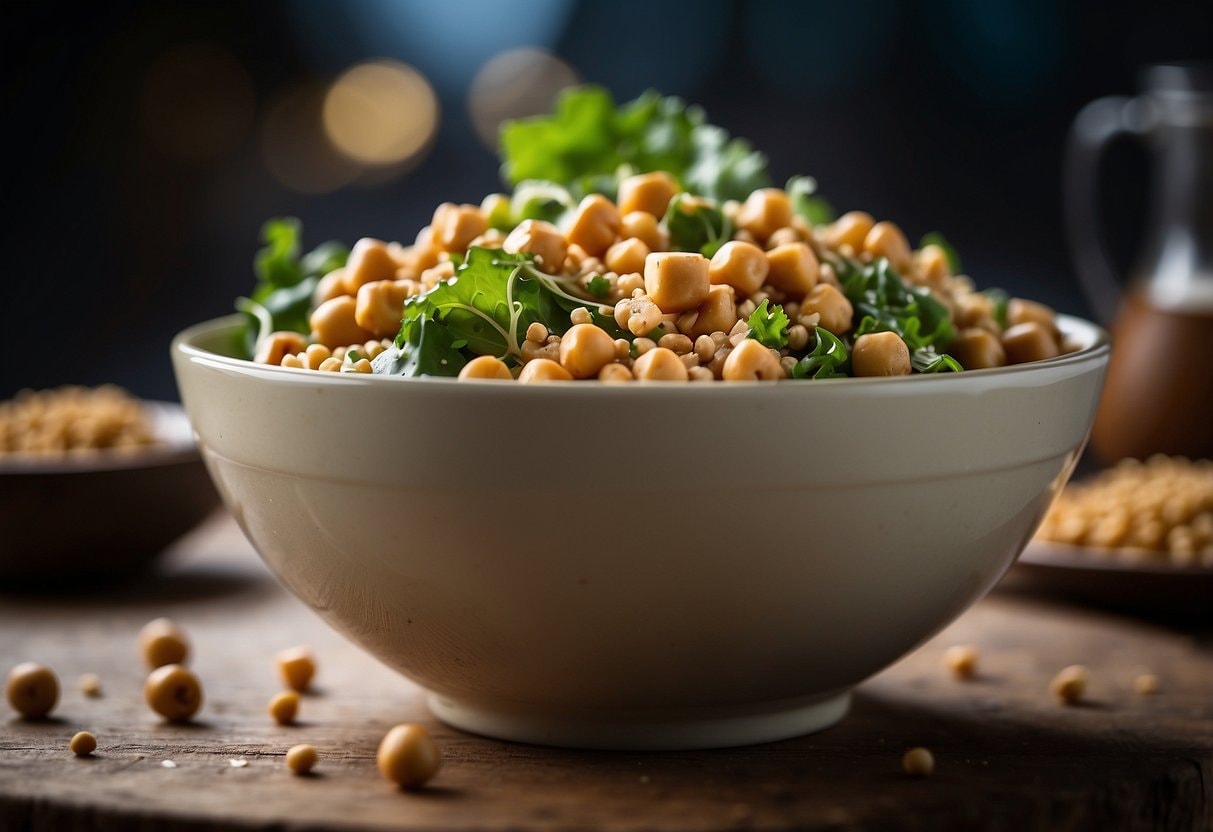
Choosing the right grain is crucial for a delicious and nutritious vegan grain bowl. I’ll cover different types of grains and how to cook them perfectly.
Types of Grains
There are many grains to choose from for your vegan bowl. Each has unique flavors and textures, making your meal varied and interesting.
Quinoa is a top choice. It is high in protein and has a slightly nutty taste. Brown rice is another good option, offering a chewy texture and nutty flavor. If you prefer something different, farro is a great choice. It is chewy and has a slightly sweet taste. Barley and bulgur are other options that can add interesting flavors and textures to your bowls.
For a gluten-free option, try Millet or buckwheat. They are both easy to cook and have great textures. I sometimes use wild rice when I want something more earthy and chewy. Mixing different grains can also create a fantastic base that keeps the meal interesting and nutritious.
Cooking Perfect Grains
Cooking grains correctly is vital for the base of your bowl. Here are some tips for perfect results. First, always rinse your grains before cooking. This removes any dust or debris. Quinoa must be rinsed to remove its natural coating, which can taste bitter.
For brown rice, use 1 cup rice to 2 cups water. Bring it to a boil, then simmer for about 45 minutes. Quinoa cooks faster. Use 1 cup quinoa to 2 cups water. Simmer for around 15 minutes. Farro and barley have similar cooking methods. Use about 2 1/2 cups of water for 1 cup of grain. Simmer until tender, which takes about 30-40 minutes.
The water-to-grain ratio is typically 2:1 for Millet and buckwheat. Millet takes about 20 minutes to cook, while buckwheat needs only about 10 minutes. I recommend watching your grains while they cook and testing for doneness. This way, they’ll be just right for your bowl.
Vegan Grain Bowl: Adding Proteins
Proteins are an essential part of a balanced vegan grain bowl. They help repair muscle, make you feel full, and provide key nutrients.

Plant-Based Protein Sources
I like to include plant-based protein sources when I build a vegan grain bowl. Some of my favorites are:
- Tofu and Tempeh: Both are made from soybeans and can be baked, fried, or grilled.
- Chickpeas and Lentils: These legumes are not only high in protein but also rich in fiber.
- Quinoa: This grain is a complete protein containing all nine essential amino acids.
- Nuts and Seeds: Almonds, sunflower, and chia seeds add a crunch and extra nutrients.
- Edamame: Young soybeans that are easy to prepare and tasty.
Using a mix of these ingredients can make your bowl delicious and protein-packed.
Balancing Macronutrients
Balancing macronutrients is crucial when adding proteins to a vegan grain bowl. I balance proteins with carbs and fats for a nutritious meal.
- Proteins: Aim for 15-25 grams of protein per bowl. This amount supports muscle repair and overall health.
- Carbs: Include whole grains like brown rice, quinoa, or farro. These provide energy and fiber.
- Fats: Healthy fats are important. I add avocados, olive oil, or nuts for a balanced fat profile.
Using this approach ensures each bowl is well-rounded. Keeping an eye on macronutrient balance makes a vegan grain bowl tasty but also nutritious and satisfying.
Incorporating Fresh Vegetables and Fruits
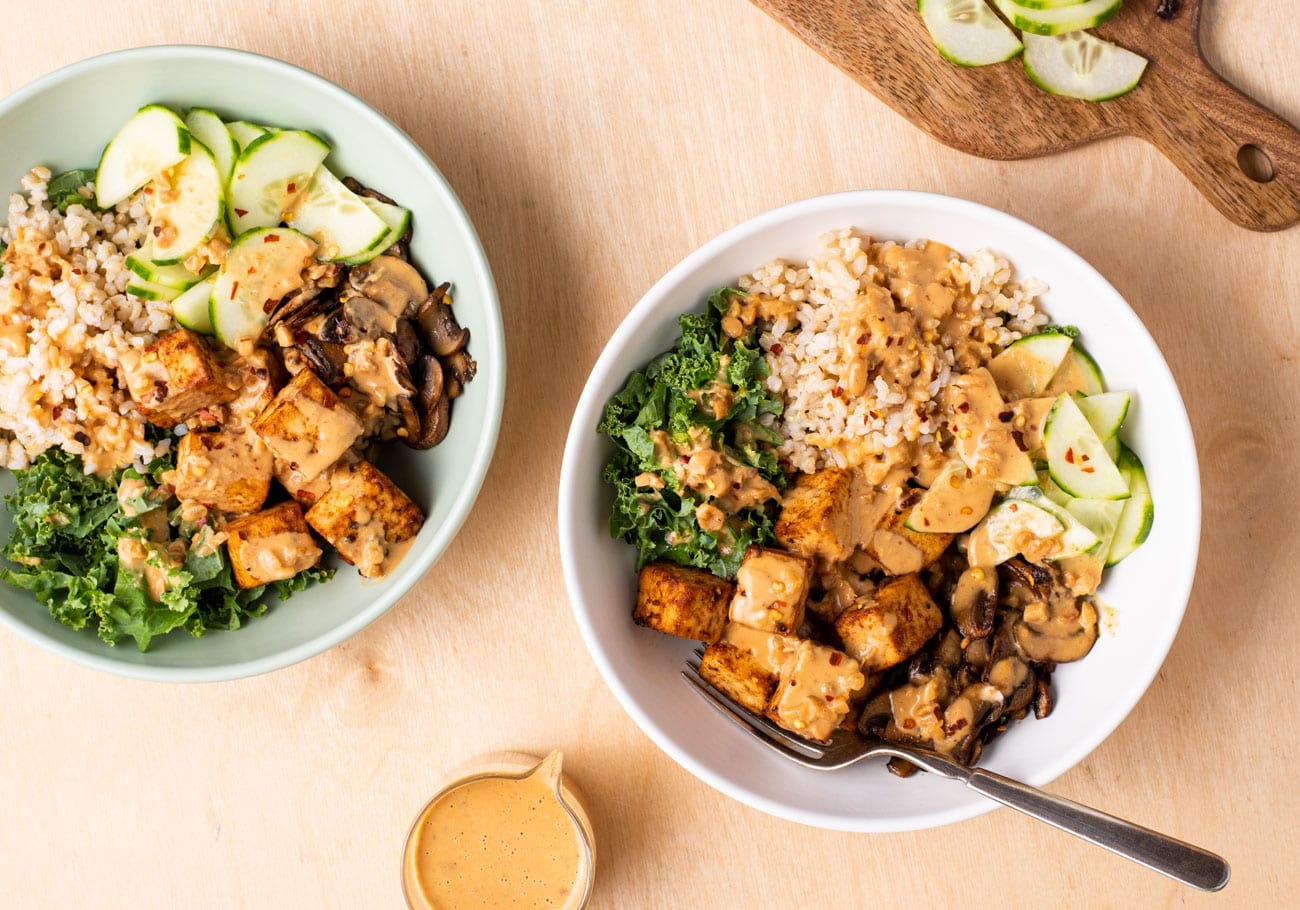
Adding fresh vegetables and fruits to a vegan grain bowl enhances its nutritional value and adds vibrant colors and varied textures. Below, I will discuss choosing the best vegetables and fruits for your bowl.
Choosing Vegetables
When selecting vegetables, it’s crucial to aim for variety and nutrition. Leafy greens like spinach and kale are excellent bases due to their high vitamin content and minimal calories.
For a crunch, I like to add bell peppers and cucumbers, which are also great for hydration. Root vegetables like sweet potatoes and carrots are delicious when roasted.
They bring a sweet, earthy flavor that contrasts well with more neutral greens. For added protein, consider vegetables like broccoli or peas. Their robust texture holds up well in grain bowls.
Incorporating Fruits
Fruits add a sweet, refreshing element to grain bowls. I often include berries like blueberries or strawberries, which are rich in antioxidants and provide bursts of flavor. Citrus fruits such as oranges or grapefruit segments are great for a tangy twist. Avocado is another excellent choice due to its creamy texture and healthy fats.
Remember cooked fruits like roasted apples or pears; they add a unique depth and warmth to the bowl. I sometimes sprinkle pomegranate seeds for a juicy crunch and an additional nutritional boost. Dried fruits like raisins or cranberries can be good, too, but use them sparingly due to their high sugar content.
Here’s an additional video to help you master the art of making a vegan grain bowl.
By: Eat with Afia
Using Healthy Fats and Dressings
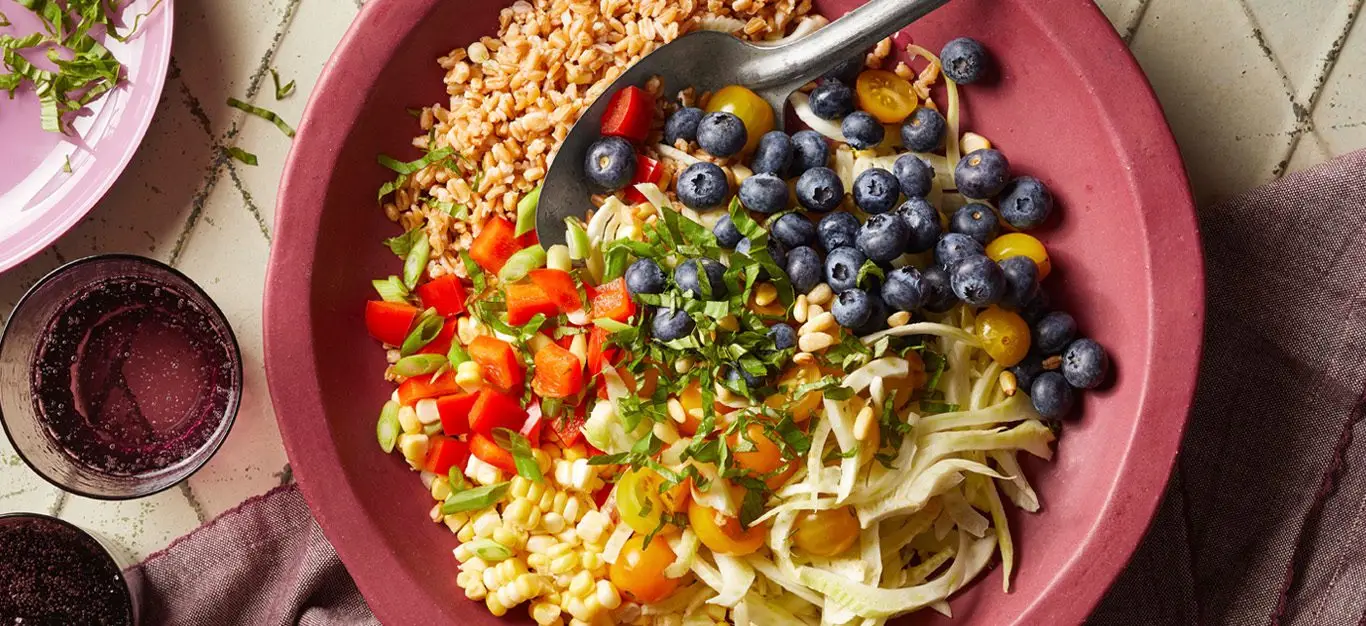
Choosing healthy fats and creating delicious dressings can elevate your vegan grain bowl. I will guide you through selecting nutritious fats and crafting dressings that enhance flavor and add essential nutrients.
Selecting Healthy Fats
Healthy fats are crucial for a balanced diet. Avocados are a fantastic option, offering a creamy texture and rich taste while providing heart-healthy monounsaturated fats. I often add about half an avocado per bowl.
Nuts and seeds like walnuts, almonds, and chia seeds are also excellent. They add crunch and are packed with omega-3 fatty acids. I usually sprinkle a tablespoon of seeds or chopped nuts on my grain bowls.
Remember olive oil. It’s rich in antioxidants and versatile. A drizzle of extra-virgin olive oil can enhance the flavors of your vegetables and grains. Although higher in saturated fats, coconut oil can occasionally be used for its unique flavor. I use it sparingly, focusing more on options like avocados and nuts.
Creating Flavorful Dressings
Having a good dressing can transform a simple bowl into a delicious meal. You can make a lemon-tahini dressing by whisking together tahini, lemon juice, water, and a pinch of salt. The creamy texture and tangy taste complement most grain bowls well.
Another favorite of mine is a balsamic vinaigrette. I mix balsamic vinegar, olive oil, Dijon mustard, and maple syrup—the sweet and tangy flavor pairs wonderfully with roasted vegetables and grains.
For a spicy kick, try a sriracha-lime dressing. Combine sriracha, lime juice, a little agave syrup, and olive oil. This adds a zesty and spicy element that lights up the bowl.
Experiment with different combinations to find what you enjoy most. The key is balancing flavors and textures to make each bite enjoyable.
Did You Know?
Several dressings can elevate a grain bowl. A homemade tahini dressing adds creaminess. A lemon-olive oil vinaigrette keeps it light and refreshing. Peanut dressing provides a nutty, flavorful punch. These dressings can be adjusted to suit individual taste preferences.
Enhancing Flavors with Toppings and Extras
Toppings and extras are key to making it delicious when I build a vegan grain bowl. I often add a mix of textures and flavors to keep things interesting.
Fresh Herbs
Fresh herbs like cilantro, parsley, or basil add flavor. I like to sprinkle them generously.
Crunchy Elements
Nuts, seeds, and roasted chickpeas provide a satisfying crunch. For example, adding a handful of almonds or sunflower seeds makes a big difference.
Creamy Additions
Avocado slices or a drizzle of tahini dressing can add creaminess. I often use hummus as a topping for an extra layer of flavor.
Dressings
A good dressing ties all the flavors together. I enjoy a simple balsamic vinaigrette or a lemon-tahini dressing.
Extra Veggies
Sometimes, I add extra raw or roasted veggies like cherry tomatoes, shredded carrots, or cucumber slices for more color and nutrition.
Adding these toppings not only makes the grain bowl more flavorful but also more nutritious. Each topping brings something unique to the dish.
Assembling Your Vegan Grain Bowl
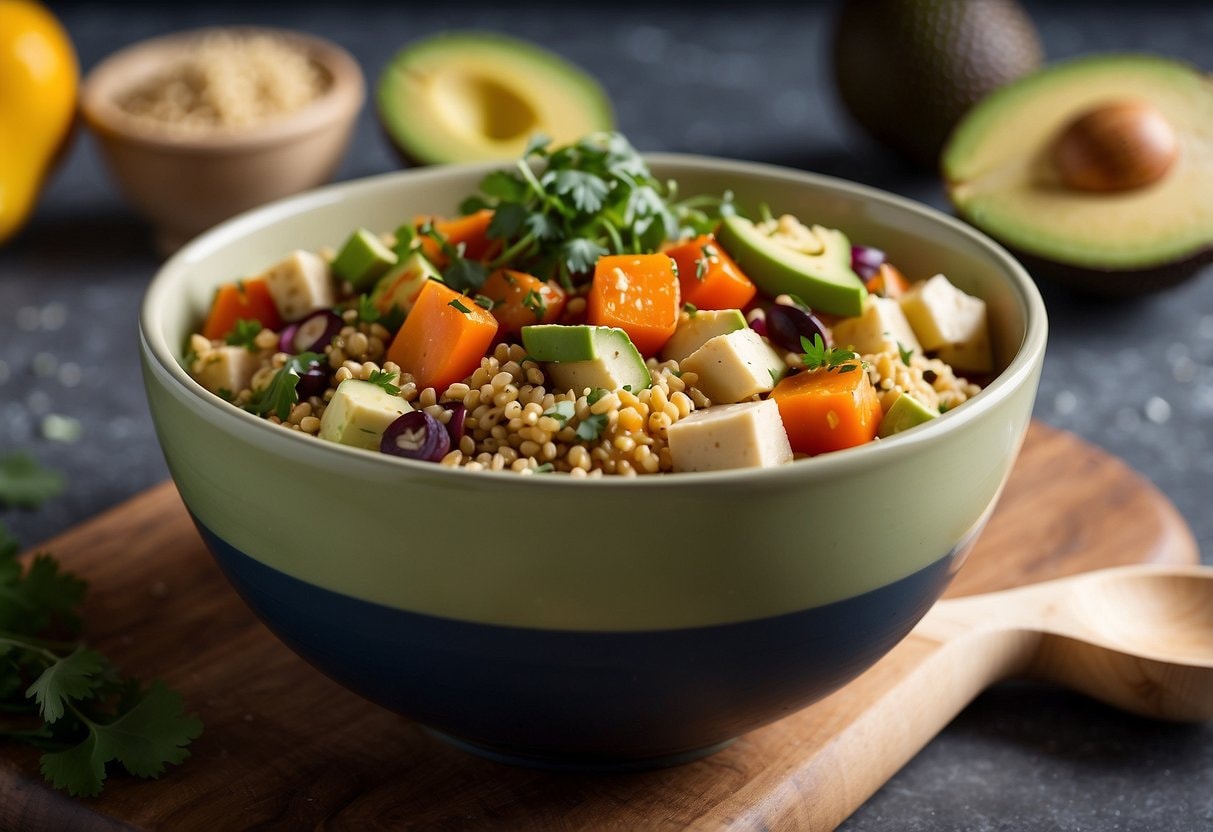
A well-prepared vegan grain bowl blends flavors, textures, and colors.
Layering Techniques
I always start with a base layer of grains. Quinoa, brown rice, and farro are great choices. After that, I add proteins like chickpeas or tofu. These ingredients should be evenly spread to ensure every bite is balanced.
Next, I layer on vegetables. Roasted sweet potatoes, fresh spinach, and shredded carrots add vibrant colors and essential nutrients. Having a mix of raw and cooked vegetables creates a pleasant contrast. Finally, I drizzle the bowl with a tasty sauce or dressing. Tahini, lemon vinaigrette, or a simple olive oil and balsamic mix work well. Adding this on top helps tie all the flavors together.
Presentation Tips
Presentation makes a big difference. I like to arrange ingredients in neat sections or small piles. This not only looks appealing but also makes each ingredient easily identifiable.
I use a large, shallow bowl to give each element space. Highlighting vibrant colors and textures adds to the visual appeal. Garnishes like chopped herbs, seeds, or nuts can elevate the look and add crunch.
I use avocado slices or a sprinkle of hemp seeds when I want to impress. Small touches can make your bowl look professionally made, enhancing the eating experience.
Here’s an additional video about vegan grain bowls
By: Kosherdotcom
Mastering the Art of the Vegan Grain Bowl
Building a Vegan Grain Bowl is more than just assembling a meal—it’s an art that balances nutrition, flavor, and creativity. By understanding and utilizing the five basic components—grains, proteins, vegetables and fruits, healthy fats, and dressings—you can craft a satisfying and nutrient-dense bowl. This guide has taught you to select and prepare each component effectively, ensuring your grain bowls are delicious, wholesome, and versatile.

Whether you are meal-prepping for the week or experimenting with new flavors, remember that the beauty of a Vegan Grain Bowl lies in its adaptability. Swap ingredients based on what’s in season or what you have on hand, and feel free to get creative with your toppings and dressings. With each bowl you make, you’ll treat your taste buds and nourish your body with a balanced, plant-based meal. Now that you have the essentials, it’s time to dive in and start building your Vegan Grain Bowls—one colorful, flavorful bite at a time.
Frequently Asked Questions
What Ingredients Are Essential for a Nutritious Vegan Grain Bowl?
A nutritious vegan grain bowl should include a variety of grains, proteins, vegetables, and healthy fats. Grains like quinoa, brown rice, or barley serve as the base. Leafy greens, roasted vegetables, and beans or legumes add nutrients and texture. Healthy fats from avocado, nuts, or seeds enhance the bowl’s nutritional profile.
What is the Best Way to Combine Flavors in a Buddha Bowl?
Combining flavors in a Buddha bowl requires balancing sweet, savory, and acidic elements. Roasted sweet potatoes, tangy pickled vegetables, and a savory tahini dressing can create a delicious contrast. Fresh herbs like cilantro or parsley and a squeeze of lemon juice can brighten the flavors.
How Can I Incorporate Protein Into a Vegan Grain Bowl Using Chickpeas?
Roasting chickpeas with olive oil and spices like paprika or cumin makes them a crunchy and tasty protein source. You can also mash chickpeas with avocado or blend them into hummus for a creamy texture. Adding them to the bowl ensures a protein-rich and satisfying meal.
Ready to Start Your Vegan Journey? Follow Us on Social Media!
Visit our accounts for delicious vegan recipes, nutritional tips, and inspiring stories from the vegan community. Join us and become part of a vibrant and compassionate network dedicated to healthy and sustainable living!



Don't miss out
when new recipes and information are added!
Join our newsletter for free recipes,
healthy living inspiration, and special offers
You have Successfully Subscribed!